International Finance Reflective Essay: Finance Module Assessment
VerifiedAdded on 2020/06/03
|11
|2510
|107
Essay
AI Summary
This reflective essay delves into the core concepts of international finance, drawing upon knowledge gained from the first six weeks of lectures. It examines the importance of international finance management, its components, and the associated risks, including foreign economies and exchange rate movements. The essay explores the concepts of absolute and comparative advantage, illustrating them with examples, and differentiates between future and forward contracts, highlighting their operational aspects and regulatory differences. Furthermore, the essay analyzes the US balance of trade in relation to a stronger dollar, assesses the accuracy of related statements, and explores the effects of the J-curve phenomenon on the economy. The essay concludes by synthesizing these concepts and their implications for economic environments in various countries, referencing key economic terms such as floating exchange rates and trade deficits.
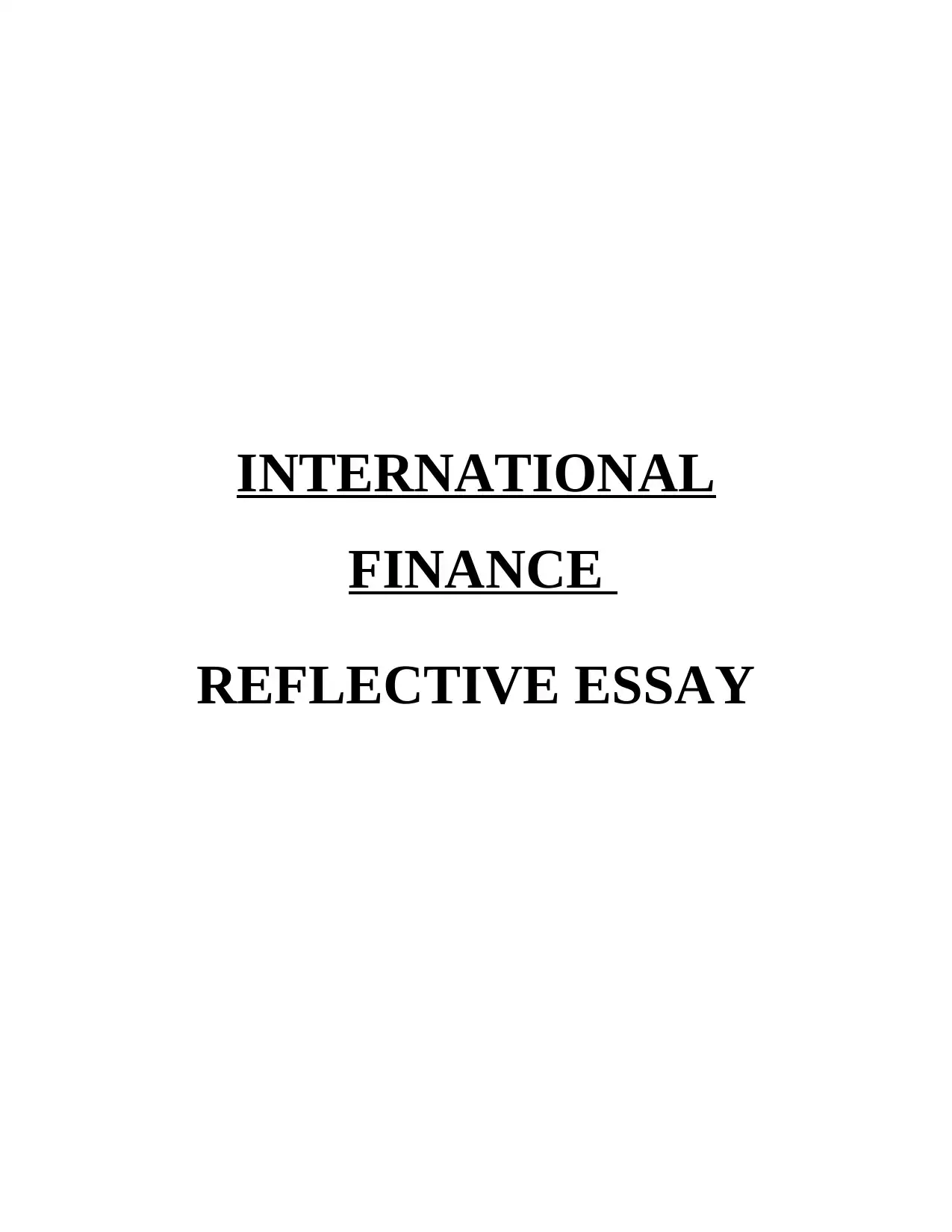
INTERNATIONAL
FINANCE
REFLECTIVE ESSAY
FINANCE
REFLECTIVE ESSAY
Paraphrase This Document
Need a fresh take? Get an instant paraphrase of this document with our AI Paraphraser
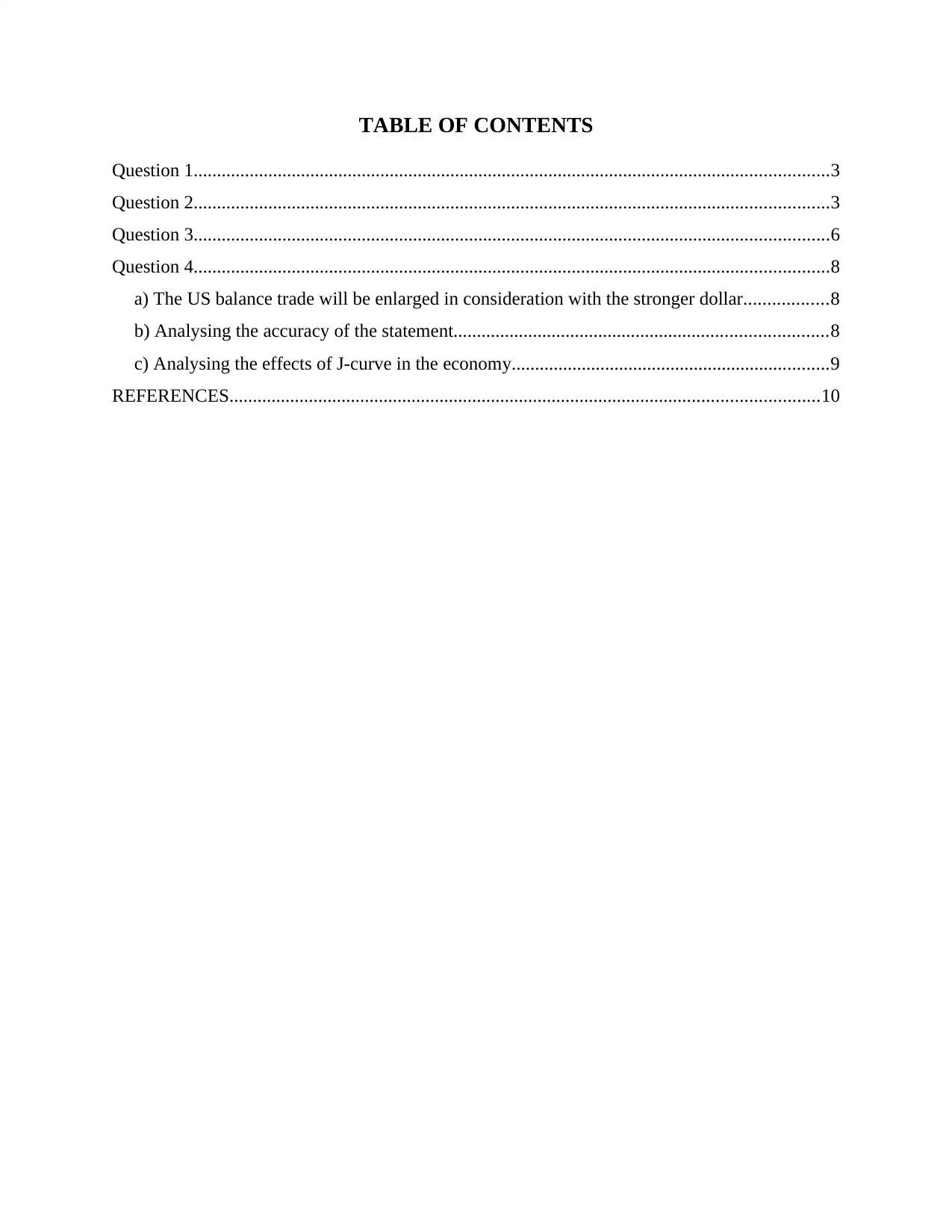
TABLE OF CONTENTS
Question 1........................................................................................................................................3
Question 2........................................................................................................................................3
Question 3........................................................................................................................................6
Question 4........................................................................................................................................8
a) The US balance trade will be enlarged in consideration with the stronger dollar..................8
b) Analysing the accuracy of the statement................................................................................8
c) Analysing the effects of J-curve in the economy....................................................................9
REFERENCES..............................................................................................................................10
Question 1........................................................................................................................................3
Question 2........................................................................................................................................3
Question 3........................................................................................................................................6
Question 4........................................................................................................................................8
a) The US balance trade will be enlarged in consideration with the stronger dollar..................8
b) Analysing the accuracy of the statement................................................................................8
c) Analysing the effects of J-curve in the economy....................................................................9
REFERENCES..............................................................................................................................10

INTRODUCTION
To have the sustainable growth in the trade and finance there will be requirement of
adequate amount of funds as well as record of all the transactions which held during the year.
However, it the present report there will be discussion based on the first 6 weeks of the lectures
and the knowledge gain through it as well as evaluating the advantages and disadvantages of
absolute and comparative advantages. The report will also highlight difference between future
and forward contracts as well as trade deficit balance in US to strengthen the dollar value. There
will be analysis of various economic terms such as Floating exchange rates and J-curve effect
over the nation's economy.
Question 1
First six weeks of the lectures provided me with bundle of knowledge about international
finance and its components. Maximising shareholder health is the main goal of multinational
corporations but in order to achieve this goal they have to face many conflicts like agency
problem, difference between shareholders and managers, etc. thus, international finance
management is essential (Miller, 2016). This provides exposure to the international risk that
includes foreign economy, political risk and exchange rate movement (Gorton and Winton,
2016). International flow of funds, international financial market and exchange rate
determination are the major components of international finance that includes balance of
payments, current accounts, capital or financial accounts, etc. It also studied about the factors
that affect international trade such as impact of inflation, national income and government
restrictions. Further I got knowledge about currency call options and currency put options.
Currency call options provides right to the buyer while, currency put provides right to the seller
to make transactions as per their requirements (Bocola and et.al., 2016). From the lectures it is
also learned that a weak currency is just not a solution to deficit in balance of trade. Knowledge
about various types of international market was also provided. The effect of international
arbitrage and interest rate parity was also learned.
Question 2
Absolute advantage and comparative advantage are two of the main concepts in the
theories of international trade that helps in describing why limited resources are used by the
countries to produce a particular type of goods.
To have the sustainable growth in the trade and finance there will be requirement of
adequate amount of funds as well as record of all the transactions which held during the year.
However, it the present report there will be discussion based on the first 6 weeks of the lectures
and the knowledge gain through it as well as evaluating the advantages and disadvantages of
absolute and comparative advantages. The report will also highlight difference between future
and forward contracts as well as trade deficit balance in US to strengthen the dollar value. There
will be analysis of various economic terms such as Floating exchange rates and J-curve effect
over the nation's economy.
Question 1
First six weeks of the lectures provided me with bundle of knowledge about international
finance and its components. Maximising shareholder health is the main goal of multinational
corporations but in order to achieve this goal they have to face many conflicts like agency
problem, difference between shareholders and managers, etc. thus, international finance
management is essential (Miller, 2016). This provides exposure to the international risk that
includes foreign economy, political risk and exchange rate movement (Gorton and Winton,
2016). International flow of funds, international financial market and exchange rate
determination are the major components of international finance that includes balance of
payments, current accounts, capital or financial accounts, etc. It also studied about the factors
that affect international trade such as impact of inflation, national income and government
restrictions. Further I got knowledge about currency call options and currency put options.
Currency call options provides right to the buyer while, currency put provides right to the seller
to make transactions as per their requirements (Bocola and et.al., 2016). From the lectures it is
also learned that a weak currency is just not a solution to deficit in balance of trade. Knowledge
about various types of international market was also provided. The effect of international
arbitrage and interest rate parity was also learned.
Question 2
Absolute advantage and comparative advantage are two of the main concepts in the
theories of international trade that helps in describing why limited resources are used by the
countries to produce a particular type of goods.
⊘ This is a preview!⊘
Do you want full access?
Subscribe today to unlock all pages.

Trusted by 1+ million students worldwide
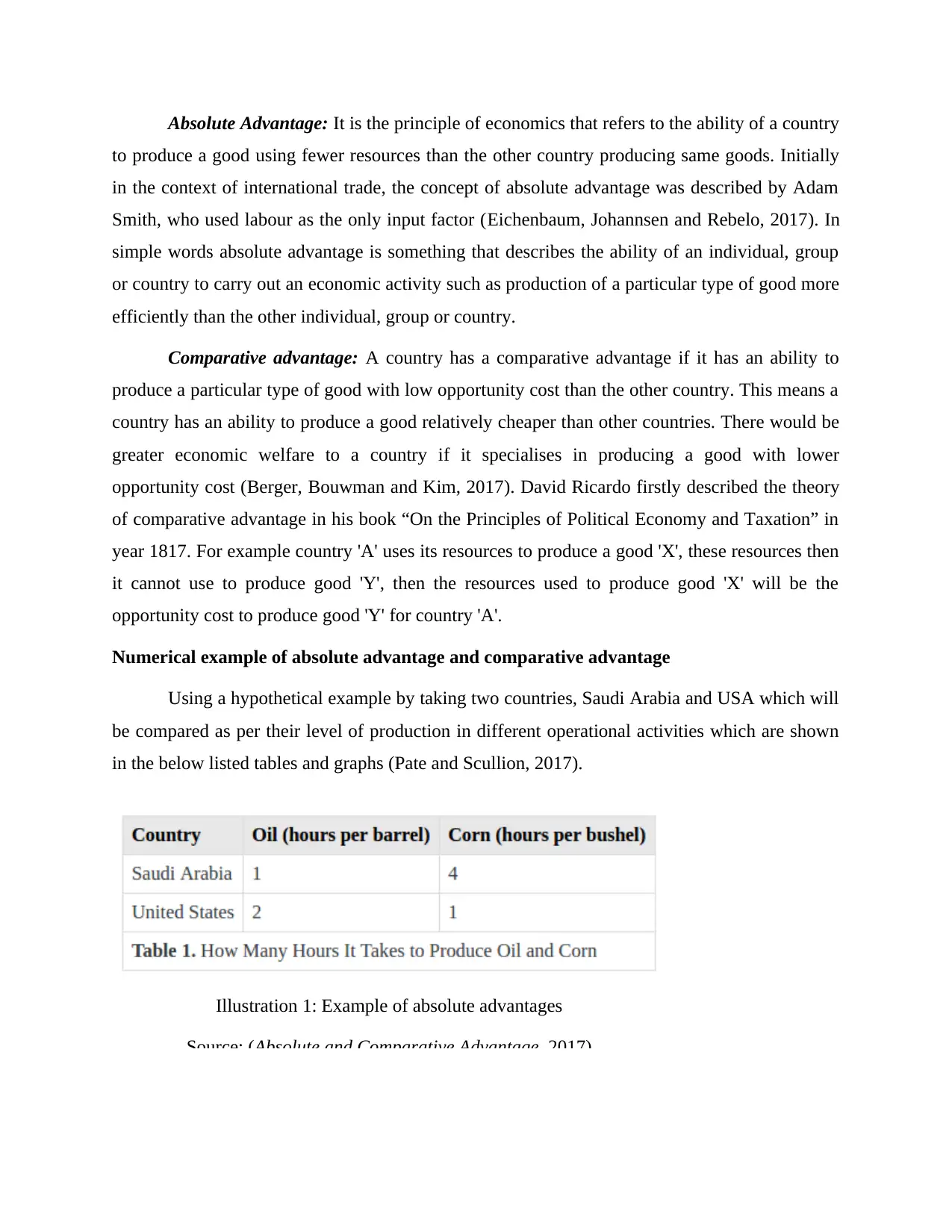
Absolute Advantage: It is the principle of economics that refers to the ability of a country
to produce a good using fewer resources than the other country producing same goods. Initially
in the context of international trade, the concept of absolute advantage was described by Adam
Smith, who used labour as the only input factor (Eichenbaum, Johannsen and Rebelo, 2017). In
simple words absolute advantage is something that describes the ability of an individual, group
or country to carry out an economic activity such as production of a particular type of good more
efficiently than the other individual, group or country.
Comparative advantage: A country has a comparative advantage if it has an ability to
produce a particular type of good with low opportunity cost than the other country. This means a
country has an ability to produce a good relatively cheaper than other countries. There would be
greater economic welfare to a country if it specialises in producing a good with lower
opportunity cost (Berger, Bouwman and Kim, 2017). David Ricardo firstly described the theory
of comparative advantage in his book “On the Principles of Political Economy and Taxation” in
year 1817. For example country 'A' uses its resources to produce a good 'X', these resources then
it cannot use to produce good 'Y', then the resources used to produce good 'X' will be the
opportunity cost to produce good 'Y' for country 'A'.
Numerical example of absolute advantage and comparative advantage
Using a hypothetical example by taking two countries, Saudi Arabia and USA which will
be compared as per their level of production in different operational activities which are shown
in the below listed tables and graphs (Pate and Scullion, 2017).
Illustration 1: Example of absolute advantages
Source: (Absolute and Comparative Advantage, 2017)
to produce a good using fewer resources than the other country producing same goods. Initially
in the context of international trade, the concept of absolute advantage was described by Adam
Smith, who used labour as the only input factor (Eichenbaum, Johannsen and Rebelo, 2017). In
simple words absolute advantage is something that describes the ability of an individual, group
or country to carry out an economic activity such as production of a particular type of good more
efficiently than the other individual, group or country.
Comparative advantage: A country has a comparative advantage if it has an ability to
produce a particular type of good with low opportunity cost than the other country. This means a
country has an ability to produce a good relatively cheaper than other countries. There would be
greater economic welfare to a country if it specialises in producing a good with lower
opportunity cost (Berger, Bouwman and Kim, 2017). David Ricardo firstly described the theory
of comparative advantage in his book “On the Principles of Political Economy and Taxation” in
year 1817. For example country 'A' uses its resources to produce a good 'X', these resources then
it cannot use to produce good 'Y', then the resources used to produce good 'X' will be the
opportunity cost to produce good 'Y' for country 'A'.
Numerical example of absolute advantage and comparative advantage
Using a hypothetical example by taking two countries, Saudi Arabia and USA which will
be compared as per their level of production in different operational activities which are shown
in the below listed tables and graphs (Pate and Scullion, 2017).
Illustration 1: Example of absolute advantages
Source: (Absolute and Comparative Advantage, 2017)
Paraphrase This Document
Need a fresh take? Get an instant paraphrase of this document with our AI Paraphraser
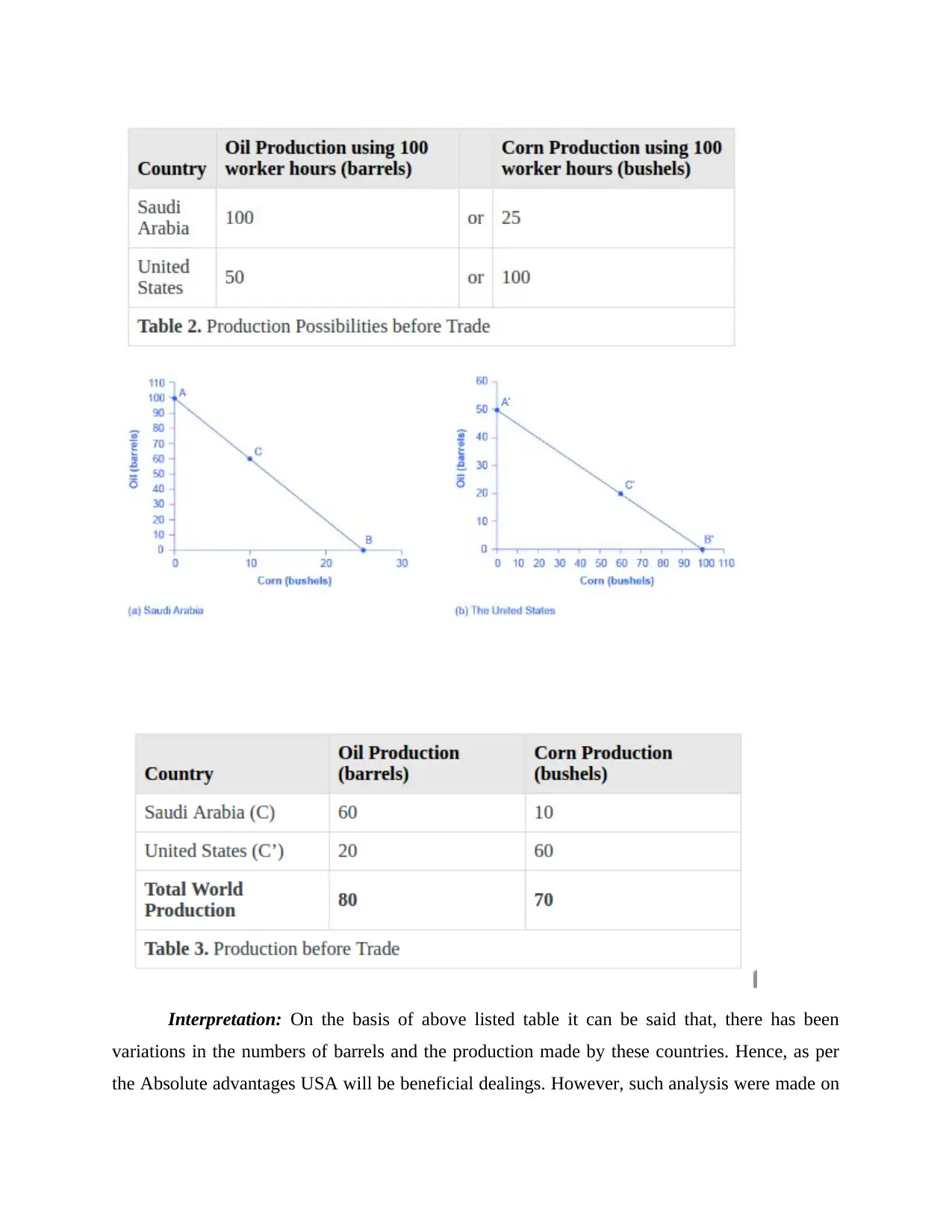
Interpretation: On the basis of above listed table it can be said that, there has been
variations in the numbers of barrels and the production made by these countries. Hence, as per
the Absolute advantages USA will be beneficial dealings. However, such analysis were made on
variations in the numbers of barrels and the production made by these countries. Hence, as per
the Absolute advantages USA will be beneficial dealings. However, such analysis were made on

the basis of the valid reason such as USA has higher productivity rate as well ass the country is
making adequate profitability in context with facilitating the sales. Thus, in accordance with the
production before trade Saudi Arabia have production of Oil for 60 barrels and corn at 10 barrels
while in context with US which has the oil production for 20 barrels and 70 barrels for corn
production.
Comparative advantages:
Interpretation: By considering the above listed table which indicates the portion of the
production made by both the countries. Hence, Saudi Arabia I has 1/4th of the production in Oil
manufacturing as well as in the corn production the which is 4 time lower than the oil
production. On the other side USA is 2 time better than oil production as per oil production and
1/2nd time better in corm production than oil production. Hence, it can be said that the availability
of the resources will affect the production process per hour.
Question 3
Future band Forward methods of contracts are different from each other. Hence, in the
Future contracts there will be influence of various laws and regulations which in turn fruitful for
the parties who are involved in agreement while in Forward agreements these are totally opposite
from each other (Barnaby and Russell, 2016). By considering the differences between future and
forward contracts there has been several variations in both the terms which will be understand as
per the below listed table
Basis Forward Future
making adequate profitability in context with facilitating the sales. Thus, in accordance with the
production before trade Saudi Arabia have production of Oil for 60 barrels and corn at 10 barrels
while in context with US which has the oil production for 20 barrels and 70 barrels for corn
production.
Comparative advantages:
Interpretation: By considering the above listed table which indicates the portion of the
production made by both the countries. Hence, Saudi Arabia I has 1/4th of the production in Oil
manufacturing as well as in the corn production the which is 4 time lower than the oil
production. On the other side USA is 2 time better than oil production as per oil production and
1/2nd time better in corm production than oil production. Hence, it can be said that the availability
of the resources will affect the production process per hour.
Question 3
Future band Forward methods of contracts are different from each other. Hence, in the
Future contracts there will be influence of various laws and regulations which in turn fruitful for
the parties who are involved in agreement while in Forward agreements these are totally opposite
from each other (Barnaby and Russell, 2016). By considering the differences between future and
forward contracts there has been several variations in both the terms which will be understand as
per the below listed table
Basis Forward Future
⊘ This is a preview!⊘
Do you want full access?
Subscribe today to unlock all pages.

Trusted by 1+ million students worldwide
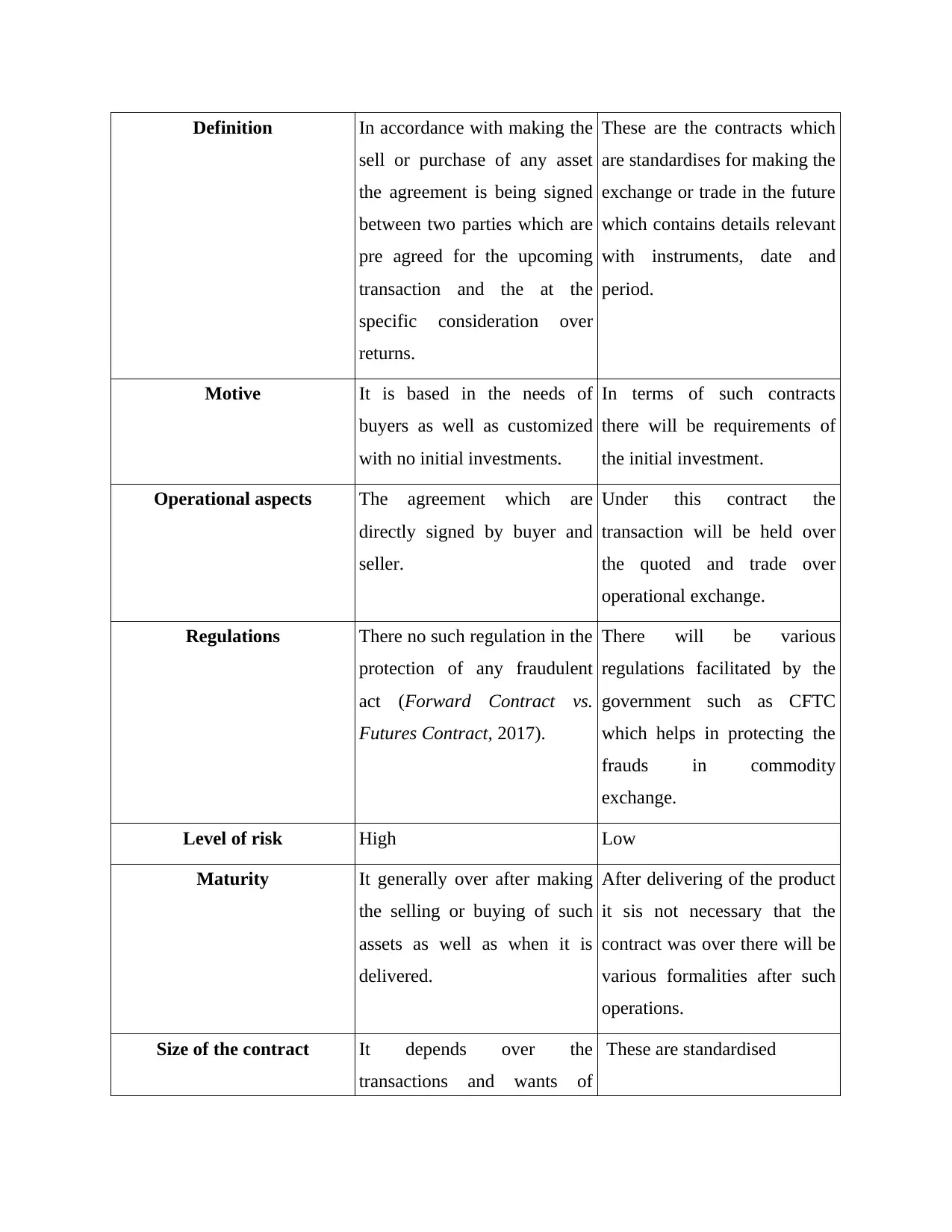
Definition In accordance with making the
sell or purchase of any asset
the agreement is being signed
between two parties which are
pre agreed for the upcoming
transaction and the at the
specific consideration over
returns.
These are the contracts which
are standardises for making the
exchange or trade in the future
which contains details relevant
with instruments, date and
period.
Motive It is based in the needs of
buyers as well as customized
with no initial investments.
In terms of such contracts
there will be requirements of
the initial investment.
Operational aspects The agreement which are
directly signed by buyer and
seller.
Under this contract the
transaction will be held over
the quoted and trade over
operational exchange.
Regulations There no such regulation in the
protection of any fraudulent
act (Forward Contract vs.
Futures Contract, 2017).
There will be various
regulations facilitated by the
government such as CFTC
which helps in protecting the
frauds in commodity
exchange.
Level of risk High Low
Maturity It generally over after making
the selling or buying of such
assets as well as when it is
delivered.
After delivering of the product
it sis not necessary that the
contract was over there will be
various formalities after such
operations.
Size of the contract It depends over the
transactions and wants of
These are standardised
sell or purchase of any asset
the agreement is being signed
between two parties which are
pre agreed for the upcoming
transaction and the at the
specific consideration over
returns.
These are the contracts which
are standardises for making the
exchange or trade in the future
which contains details relevant
with instruments, date and
period.
Motive It is based in the needs of
buyers as well as customized
with no initial investments.
In terms of such contracts
there will be requirements of
the initial investment.
Operational aspects The agreement which are
directly signed by buyer and
seller.
Under this contract the
transaction will be held over
the quoted and trade over
operational exchange.
Regulations There no such regulation in the
protection of any fraudulent
act (Forward Contract vs.
Futures Contract, 2017).
There will be various
regulations facilitated by the
government such as CFTC
which helps in protecting the
frauds in commodity
exchange.
Level of risk High Low
Maturity It generally over after making
the selling or buying of such
assets as well as when it is
delivered.
After delivering of the product
it sis not necessary that the
contract was over there will be
various formalities after such
operations.
Size of the contract It depends over the
transactions and wants of
These are standardised
Paraphrase This Document
Need a fresh take? Get an instant paraphrase of this document with our AI Paraphraser

contracting individuals.
Question 4
a) The US balance trade will be enlarged in consideration with the stronger dollar
In terms of making the improvements in the US dollars there is need to expand the
exports in compare with the level of imports made during a period. Hence, it can be said that
there is need to make improvements in the EXIM policy of country as well as reducing the rated
over exporting a material, product or services (Alessandria and Choi, 2016). Hence, it can be
said that such reforms will help in enhancing the GDP rate of the country as well as helps in
enhancing the currency rates in international market. However, it can be said that the balance or
trade will be over the favourable scale than there will be fruitful changes in the currency rates
and the current accounts of USA. Hence, it can be said that there is need to enhance the currency
rates which will be due to increase in the domestic production as well as rise in the economy of
small scale industry which in turn motivate them to make the expansion in their operational
aspects.
b) Analysing the accuracy of the statement
In accordance with the exchange rates, currency rates and the net sale obtained by the
country there will be variations in their current accounts and the rates of the currencies. Hence,
such impacts will lower down the currency value of such nation. Thus, it can be said that the
statements is true and total lies with the condition that the reduction in the currency will
eventually reduce the demands for such imported goods and supply as well as there will be
increase in the level or volume or exports (Komar, Uniiat and Lutsiv, 2016). However, it can be
said that the changes will help in enhancing the level of domestic production as well as beneficial
for the small industries. Thus, if the level of the small scale business is improved than the
national economy will be beneficial in making having the stable currency rates as well as they
will be less depended over the imports of any commodity.
Question 4
a) The US balance trade will be enlarged in consideration with the stronger dollar
In terms of making the improvements in the US dollars there is need to expand the
exports in compare with the level of imports made during a period. Hence, it can be said that
there is need to make improvements in the EXIM policy of country as well as reducing the rated
over exporting a material, product or services (Alessandria and Choi, 2016). Hence, it can be
said that such reforms will help in enhancing the GDP rate of the country as well as helps in
enhancing the currency rates in international market. However, it can be said that the balance or
trade will be over the favourable scale than there will be fruitful changes in the currency rates
and the current accounts of USA. Hence, it can be said that there is need to enhance the currency
rates which will be due to increase in the domestic production as well as rise in the economy of
small scale industry which in turn motivate them to make the expansion in their operational
aspects.
b) Analysing the accuracy of the statement
In accordance with the exchange rates, currency rates and the net sale obtained by the
country there will be variations in their current accounts and the rates of the currencies. Hence,
such impacts will lower down the currency value of such nation. Thus, it can be said that the
statements is true and total lies with the condition that the reduction in the currency will
eventually reduce the demands for such imported goods and supply as well as there will be
increase in the level or volume or exports (Komar, Uniiat and Lutsiv, 2016). However, it can be
said that the changes will help in enhancing the level of domestic production as well as beneficial
for the small industries. Thus, if the level of the small scale business is improved than the
national economy will be beneficial in making having the stable currency rates as well as they
will be less depended over the imports of any commodity.
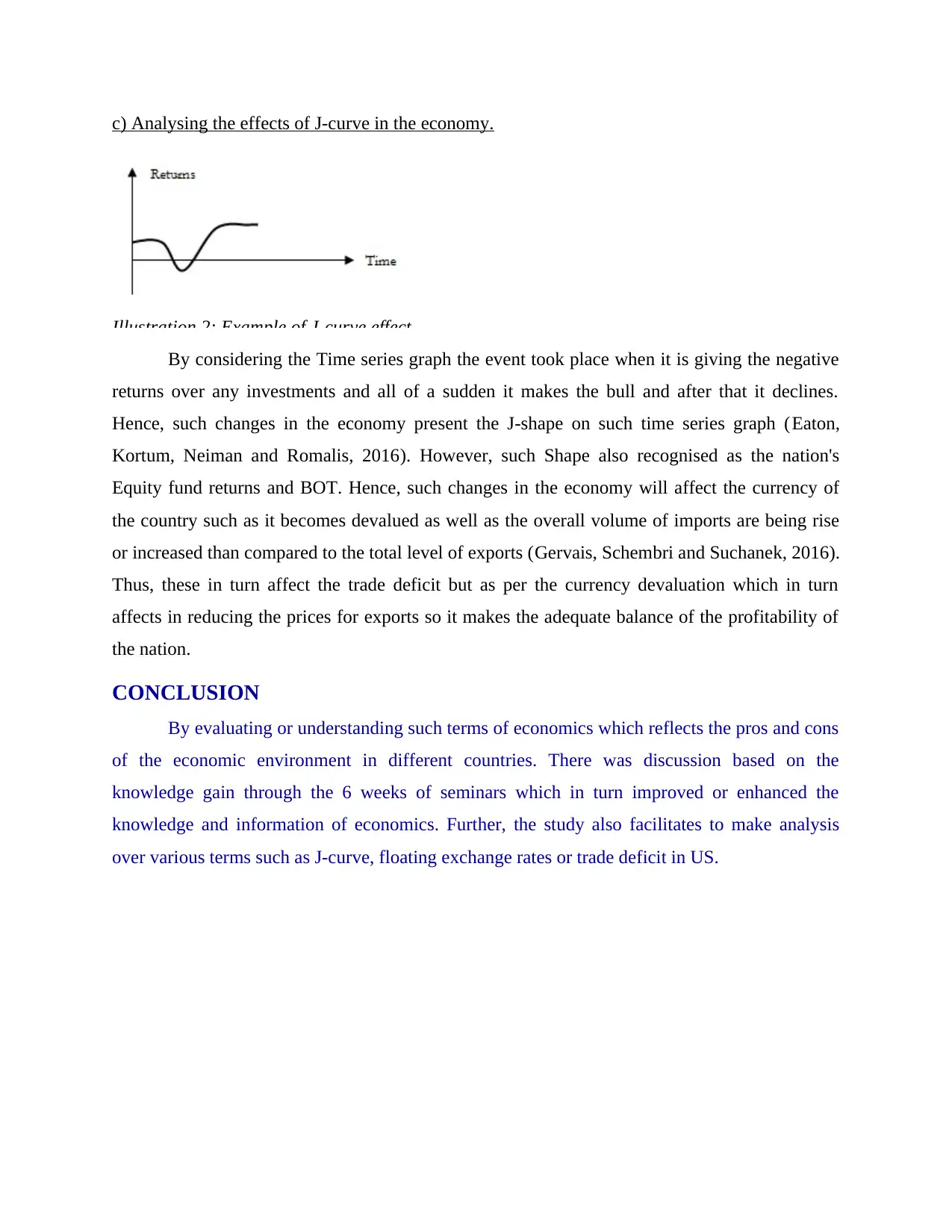
c) Analysing the effects of J-curve in the economy.
Illustration 2: Example of J-curve effect
By considering the Time series graph the event took place when it is giving the negative
returns over any investments and all of a sudden it makes the bull and after that it declines.
Hence, such changes in the economy present the J-shape on such time series graph (Eaton,
Kortum, Neiman and Romalis, 2016). However, such Shape also recognised as the nation's
Equity fund returns and BOT. Hence, such changes in the economy will affect the currency of
the country such as it becomes devalued as well as the overall volume of imports are being rise
or increased than compared to the total level of exports (Gervais, Schembri and Suchanek, 2016).
Thus, these in turn affect the trade deficit but as per the currency devaluation which in turn
affects in reducing the prices for exports so it makes the adequate balance of the profitability of
the nation.
CONCLUSION
By evaluating or understanding such terms of economics which reflects the pros and cons
of the economic environment in different countries. There was discussion based on the
knowledge gain through the 6 weeks of seminars which in turn improved or enhanced the
knowledge and information of economics. Further, the study also facilitates to make analysis
over various terms such as J-curve, floating exchange rates or trade deficit in US.
Illustration 2: Example of J-curve effect
By considering the Time series graph the event took place when it is giving the negative
returns over any investments and all of a sudden it makes the bull and after that it declines.
Hence, such changes in the economy present the J-shape on such time series graph (Eaton,
Kortum, Neiman and Romalis, 2016). However, such Shape also recognised as the nation's
Equity fund returns and BOT. Hence, such changes in the economy will affect the currency of
the country such as it becomes devalued as well as the overall volume of imports are being rise
or increased than compared to the total level of exports (Gervais, Schembri and Suchanek, 2016).
Thus, these in turn affect the trade deficit but as per the currency devaluation which in turn
affects in reducing the prices for exports so it makes the adequate balance of the profitability of
the nation.
CONCLUSION
By evaluating or understanding such terms of economics which reflects the pros and cons
of the economic environment in different countries. There was discussion based on the
knowledge gain through the 6 weeks of seminars which in turn improved or enhanced the
knowledge and information of economics. Further, the study also facilitates to make analysis
over various terms such as J-curve, floating exchange rates or trade deficit in US.
⊘ This is a preview!⊘
Do you want full access?
Subscribe today to unlock all pages.

Trusted by 1+ million students worldwide

REFERENCES
Books and Journals
Gorton, G. B. and Winton, A., 2016. Liquidity provision, bank capital, and the macroeconomy.
Miller, R., 2016. Shareholder Advocacy In Corporate Elections: Case Studies In Proxy Voting
Websites For Retail Investors.
Bocola, L. and et.al., 2016. Sustainable Exchange Rates. In 2016 Meeting Papers (No. 1396).
Society for Economic Dynamics.
Eichenbaum, M., Johannsen, B. K. and Rebelo, S., 2017. Monetary policy and the predictability
of nominal exchange rates (No. w23158). National Bureau of Economic Research.
Berger, A. N., Bouwman, C.H. and Kim, D., 2017. Small bank comparative advantages in
alleviating financial constraints and providing liquidity insurance over time. The Review of
Financial Studies, p.hhx038.
Pate, J. and Scullion, H., 2017. The flexpatriate psychological contract: a literature review and
future research agenda. The International Journal of Human Resource Management, pp.1-24.
Barnaby, G. A. and Russell, L. A., 2016. Crop Insurance Will Be at the Center of the 2019 Farm
Bill Debate. Choices. 31(3).
Alessandria, G. and Choi, H., 2016. The Dynamics of the US Trade Balance and the Real
Exchange Rate: The J Curve and Trade Costs?.
Komar, N., Uniiat, A. and Lutsiv, R., 2016. Efficiency of the North American Free Trade Zone.
Journal of european economy, (15,№ 3), pp.279-293.
Eaton, J., Kortum, S., Neiman, B. and Romalis, J., 2016. Trade and the global recession. The
American Economic Review. 106(11). pp.3401-3438.
Gervais, O., Schembri, L. and Suchanek, L., 2016. Current account dynamics, real exchange rate
adjustment, and the exchange rate regime in emerging-market economies. Journal of
Development Economics. 119. pp.86-99.
Online
Absolute and Comparative Advantage. 2017. [Online]. Available through
:<https://opentextbc.ca/principlesofeconomics/chapter/33-1-absolute-and-comparative-
advantage/>.
Books and Journals
Gorton, G. B. and Winton, A., 2016. Liquidity provision, bank capital, and the macroeconomy.
Miller, R., 2016. Shareholder Advocacy In Corporate Elections: Case Studies In Proxy Voting
Websites For Retail Investors.
Bocola, L. and et.al., 2016. Sustainable Exchange Rates. In 2016 Meeting Papers (No. 1396).
Society for Economic Dynamics.
Eichenbaum, M., Johannsen, B. K. and Rebelo, S., 2017. Monetary policy and the predictability
of nominal exchange rates (No. w23158). National Bureau of Economic Research.
Berger, A. N., Bouwman, C.H. and Kim, D., 2017. Small bank comparative advantages in
alleviating financial constraints and providing liquidity insurance over time. The Review of
Financial Studies, p.hhx038.
Pate, J. and Scullion, H., 2017. The flexpatriate psychological contract: a literature review and
future research agenda. The International Journal of Human Resource Management, pp.1-24.
Barnaby, G. A. and Russell, L. A., 2016. Crop Insurance Will Be at the Center of the 2019 Farm
Bill Debate. Choices. 31(3).
Alessandria, G. and Choi, H., 2016. The Dynamics of the US Trade Balance and the Real
Exchange Rate: The J Curve and Trade Costs?.
Komar, N., Uniiat, A. and Lutsiv, R., 2016. Efficiency of the North American Free Trade Zone.
Journal of european economy, (15,№ 3), pp.279-293.
Eaton, J., Kortum, S., Neiman, B. and Romalis, J., 2016. Trade and the global recession. The
American Economic Review. 106(11). pp.3401-3438.
Gervais, O., Schembri, L. and Suchanek, L., 2016. Current account dynamics, real exchange rate
adjustment, and the exchange rate regime in emerging-market economies. Journal of
Development Economics. 119. pp.86-99.
Online
Absolute and Comparative Advantage. 2017. [Online]. Available through
:<https://opentextbc.ca/principlesofeconomics/chapter/33-1-absolute-and-comparative-
advantage/>.
Paraphrase This Document
Need a fresh take? Get an instant paraphrase of this document with our AI Paraphraser

Forward Contract vs. Futures Contract. 2017. [Online]. Available through
:<https://www.diffen.com/difference/Forward_Contract_vs_Futures_Contract>.
:<https://www.diffen.com/difference/Forward_Contract_vs_Futures_Contract>.
1 out of 11
Related Documents
Your All-in-One AI-Powered Toolkit for Academic Success.
+13062052269
info@desklib.com
Available 24*7 on WhatsApp / Email
![[object Object]](/_next/static/media/star-bottom.7253800d.svg)
Unlock your academic potential
Copyright © 2020–2025 A2Z Services. All Rights Reserved. Developed and managed by ZUCOL.



